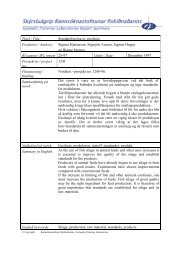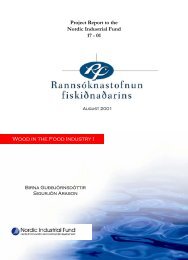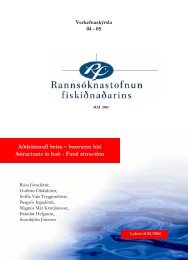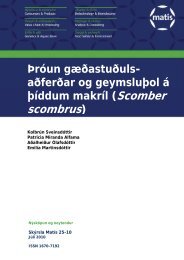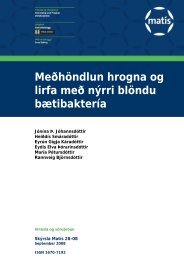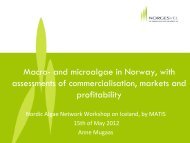Microbiology and Spoilage Trail in Nile Perch (Lates niloticus), Lake ...
Microbiology and Spoilage Trail in Nile Perch (Lates niloticus), Lake ...
Microbiology and Spoilage Trail in Nile Perch (Lates niloticus), Lake ...
You also want an ePaper? Increase the reach of your titles
YUMPU automatically turns print PDFs into web optimized ePapers that Google loves.
5 DISCUSSION<br />
5.1 PHASE I: NATURAL MICROBIOLOGY OF WATER, SEDIMENTS AND<br />
WHOLE NILE PERCH<br />
Bacteria <strong>in</strong> aquatic environment may be categorised <strong>in</strong>to two groups which <strong>in</strong>clude those<br />
that are naturally present <strong>in</strong> the aquatic environment (<strong>in</strong>digenous bacteria) <strong>and</strong> others that<br />
could be present as a result of contam<strong>in</strong>ation by human or animal or bird’s wastes or<br />
contam<strong>in</strong>ation dur<strong>in</strong>g post-harvest h<strong>and</strong>l<strong>in</strong>g <strong>and</strong> process<strong>in</strong>g. The general results on<br />
microbiology of surface water, the bottom sediments <strong>and</strong> surface sk<strong>in</strong> <strong>and</strong> guts of <strong>Nile</strong><br />
perch <strong>in</strong> connection to the aquatic environment <strong>in</strong>dicate different levels of microorganisms.<br />
5.1.1 Phase I trial 1: Water<br />
Low counts of microorganisms <strong>in</strong> water often <strong>in</strong>dicate that the water is not polluted by<br />
animal manures or human wastes. On the other h<strong>and</strong> it implies that the water is not rich<br />
habitat of microorganisms because it is poor <strong>in</strong> nutritional content required by the habitats<br />
<strong>and</strong> growth of most microorganisms (Adams <strong>and</strong> Moss, 2008). Presence of E. coli is<br />
obviously <strong>in</strong>dicat<strong>in</strong>g possibilities of resent contam<strong>in</strong>ation from animals or birds. While for<br />
presumptive Vibrio cholerae it could imply that Vibrio spp. is part of the <strong>in</strong>digenous micro<br />
flora of the aquatic environment where it is reported to occur naturally (Popovic et al.,<br />
1993).<br />
5.1.2 Phase I trial 2: Sediments<br />
The significant total viable counts results on sediments may be taken <strong>in</strong>to account that the<br />
sediments are natural reservoir of aquatic environmental (<strong>in</strong>digenous) micro flora that may<br />
contribute to the microbial load <strong>in</strong> liv<strong>in</strong>g fish. Sediments may be the major source of<br />
contam<strong>in</strong>ation <strong>in</strong> catches/ fishes but it depends on method of fish<strong>in</strong>g like trawl<strong>in</strong>g which<br />
may lead to high contam<strong>in</strong>ation, less with nets <strong>and</strong> least with long l<strong>in</strong>e methods. The low<br />
numbers of Enterobacteriaeceae, E. coli <strong>and</strong> the absence of pathogenic microorganisms <strong>in</strong><br />
sediments <strong>in</strong>dicate that this family (Enterobacteriaceae) do not survive well <strong>in</strong> sediment as<br />
it is only dom<strong>in</strong>ant <strong>in</strong> the guts of animals such as fish. It also implies that there was no<br />
58




